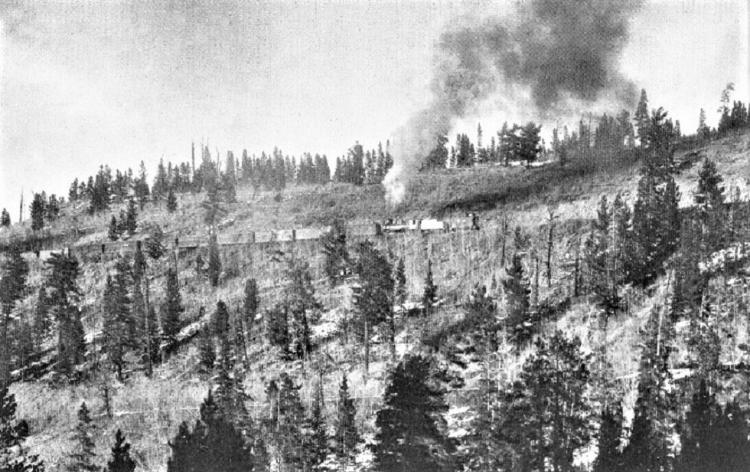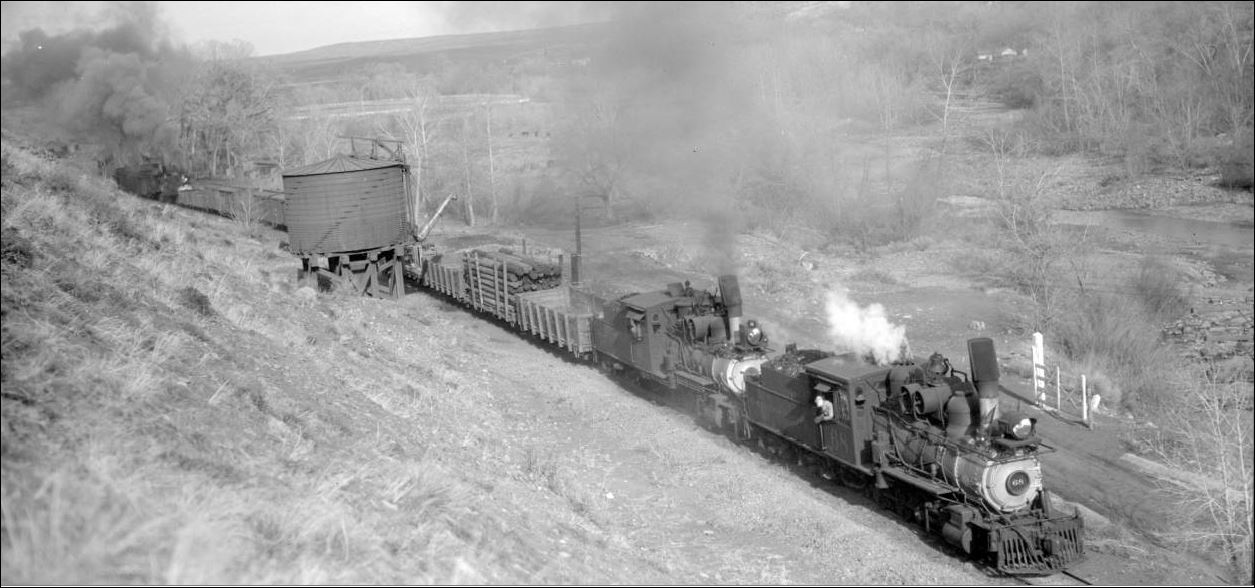Placement of Helper Engines (Reply from "Caboose that Never Was" Topic)
Placement of Helper Engines (Reply from "Caboose that Never Was" Topic)
|
Administrator
|
Rather than add this to the end of the "Caboose that Never Was" topic from which the following partial post Jim Courtney posted and I copied here, I thought I'd reply with a new thread in case further discussion may occur:
From Jim C: Other photos show helpers cut into the middle of the train, especially the four engine freights of the last years, from Denver to Leadville. A cursory look through my books and scanned photos show that even 2 engine trains, if not double headed, had the second engine cut into the middle of the train. I recall, but haven't located, a photo of the Como to Gunnison mixed train, with 3 engines--double headed on front, rear helper pushing the combine. This is the only photo that I can recall of a rear helper on a late 1930's C&S freight:  From what Doug Schnarbusch told me years ago, placement of the helper engines on upgrade tangents was made at the discretion of the Conductor. Factors which would have been at play would have included locomotive tonnage ratings, and also tonnage and placement of tonnage within the context of each train. Also at play would have been the number of helpers available. My impression would be that a two engine train, which would have only been 6 to 10 loads would have either been doubleheaded or have the helper either mid train or ahead of the caboose. In a three engine train, of up to 10-15 loads, there could be two doubleheaded on the front with the third engine as either a mid train helper or cut in ahead of the caboose. A four engine freight, which could have been 15 to 20 loads, would most likely have been doubleheaded, one mid train, and one cut in ahead of the caboose. Variations to this may appear especially with greater number of cars due to empties, and where the empties were placed within the train. The idea, of course, would have been to more evenly distribute the load on the drawbars, and the Conductor would have been keenly aware how to best do that for each train. Weather may also have been a factor. This practice probably could be traced back to South Park days. So there may be a variety of pictures showing various placements of helpers, but it's a certain bet that there were a great many more trains not photographed than trains that were, especially on the West End, due to the remote locations and that almost all freight was run during the week. |
Re: Placement of Helper Engines (Reply from "Caboose that Never Was" Topic)
|
Semi-related question .....
How is it that locomotive crews coordinated how much throttle they put to the rails on multi-engine trains, to avoid bunching up the cars and essentially pushing the cars off the track between the locomotives ? Today, it is radio controlled by "MU"ing. But back then ?
"Duty above all else except Honor"
|
Re: Placement of Helper Engines (Reply from "Caboose that Never Was" Topic)
|
This post was updated on .
In reply to this post by Mike Trent
At Waterton ...#68-69-8-58
 http://digital.denverlibrary.org/cdm/singleitem/collection/p15330coll22/id/42535/rec/5 Both trains look to have the rear pair in at least 4 cars + Bobber. At Waterton ...#537-68-74-65 : depending on which caption, this train was either 24 or 25 cars total.  http://digital.denverlibrary.org/cdm/fullbrowser/collection/p15330coll22/id/45813/rv/singleitem/rec/18 Mineral Belt 2 and Gunnison Division have the photos of the Double-header with Pusher+Combine on the rear out of Pitkin. One photo in Gunnison Division shows a great shot of two Pushers ahead of the Combine on the rear with two more Pushers behind, can't see the head-end in the picture, also in the Pitkin area. Gunnison Division also has a photo showing a Freight entering the Alpine Tunnel, with a Pusher +Combine on the rear. Another loco is close behind but appears to be a gap between it and the Combine. Klinger states it is helping, maybe posed for the picture, who knows. Edit: This is not the above described picture.  SEE Doug's post for a Clear Creek entrained Pusher http://c-sng-discussion-forum.41377.n7.nabble.com/Elk-Creek-Tank-or-Every-Now-and-Then-I-Get-Lucky-tp1294p1412.html
UpSideDownC
in New Zealand |
Re: Placement of Helper Engines (Reply from "Caboose that Never Was" Topic)
|
In reply to this post by South Park
South Park,
The road Engineer controls the speed of the train with throttle and Airbrake(train), any assisting Engineer just supplies power. Co-ordination between successive crews was by Whistle signals and operating road knowledge, once the order was given to start the train, and the gradient(s) warranted it, usually the assisting loco got shoving hard out once they had the slack in or out as the case maybe depending on placement. You also knew the other man most likely and what he was going to do in any given location. Remember that the trains on the steep narrow gauge lines were rather short, a small loco soon has its rated load in only a few cars regardless of its placement. Only those long Pipe trains run on the D&RG(W)'s Alamosa-Durango line would be any challenge and then there were strict rules as to placement and consist makeup. I only ever got on the rear twice to help a stalled train, and only in one case we shoved like hell: the other time was to help a stalled Passenger excursion, that I had excessive power and a heavy train hanging off it, so I was a bit on the ginger. If it had been a freight I probably would have given it the herbs. Got on the front of stalled(or broken down) more often since it was safer and were usually sent to help.
UpSideDownC
in New Zealand |
Re: Placement of Helper Engines (Reply from "Caboose that Never Was" Topic)
|
So, what you are saying is, it really was an acquired skill in both handling the machine,
knowing the road, knowing how the head engineer would lead, and thusly, what level of push he needed, .... and some understanding of the weights and loads being handled ? Seems like it would be all too easy to push too hard on a curve, with the movement and loads just right, and accordian the whole train off the rails and over a cliff.
"Duty above all else except Honor"
|
Re: Placement of Helper Engines (Reply from "Caboose that Never Was" Topic)
|
Administrator
|
That's about right, SP.
But the guys holding the right side of the locomotives, and many of the Firemen too, had decades of service under their belts. At least they did on the West End. Some of the East End guys were a little younger. But pretty much everybody had years of experience. Still, accidents happened. The wreck on Boreas Pass in January of '36 was caused by an engineer pulling the whistle twice for all clear instead of once to proceed with caution in a driving blizzard. That resulted in the death of the engineer on #75 who was pushing #73 with a flanger downgrade. Railroading is an unforgiving way of life. |
Re: Placement of Helper Engines (Reply from "Caboose that Never Was" Topic)
|
Railroading is an unforgiving way of life.
Amen Mike, that still holds true even in this day and age. Rules, and Rule changes usually are written in Blood. Since I started in '77 I know of 9 Enginemen killed on the job, one being a Fireman who was a trainee with me, one an Enginedriver from my old Depot who I fired for numerous times, one who was a Fireman for me occasionally until one-man operation came in.
UpSideDownC
in New Zealand |
«
Return to C&Sng Discussion Forum
|
1 view|%1 views
| Free forum by Nabble | Edit this page |

